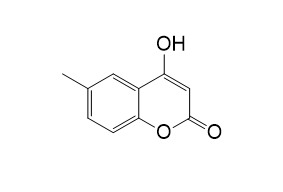4-Hydroxy-6-methylcoumarinCAS# 13252-83-0 |

Quality Control & MSDS
Package In Stock
Number of papers citing our products

| Cas No. | 13252-83-0 | SDF | Download SDF |
| PubChem ID | N/A | Appearance | Powder |
| Formula | C10H8O3 | M.Wt | 176.1 |
| Type of Compound | Coumarins | Storage | Desiccate at -20°C |
| Solubility | Soluble in Chloroform,Dichloromethane,Ethyl Acetate,DMSO,Acetone,etc. | ||
| General tips | For obtaining a higher solubility , please warm the tube at 37 ℃ and shake it in the ultrasonic bath for a while.Stock solution can be stored below -20℃ for several months. We recommend that you prepare and use the solution on the same day. However, if the test schedule requires, the stock solutions can be prepared in advance, and the stock solution must be sealed and stored below -20℃. In general, the stock solution can be kept for several months. Before use, we recommend that you leave the vial at room temperature for at least an hour before opening it. |
||
| About Packaging | 1. The packaging of the product may be reversed during transportation, cause the high purity compounds to adhere to the neck or cap of the vial.Take the vail out of its packaging and shake gently until the compounds fall to the bottom of the vial. 2. For liquid products, please centrifuge at 500xg to gather the liquid to the bottom of the vial. 3. Try to avoid loss or contamination during the experiment. |
||
| Shipping Condition | Packaging according to customer requirements(5mg, 10mg, 20mg and more). Ship via FedEx, DHL, UPS, EMS or other couriers with RT, or blue ice upon request. | ||
| Description | Reference standards. | |||||

4-Hydroxy-6-methylcoumarin Dilution Calculator

4-Hydroxy-6-methylcoumarin Molarity Calculator
| 1 mg | 5 mg | 10 mg | 20 mg | 25 mg | |
| 1 mM | 5.6786 mL | 28.393 mL | 56.7859 mL | 113.5718 mL | 141.9648 mL |
| 5 mM | 1.1357 mL | 5.6786 mL | 11.3572 mL | 22.7144 mL | 28.393 mL |
| 10 mM | 0.5679 mL | 2.8393 mL | 5.6786 mL | 11.3572 mL | 14.1965 mL |
| 50 mM | 0.1136 mL | 0.5679 mL | 1.1357 mL | 2.2714 mL | 2.8393 mL |
| 100 mM | 0.0568 mL | 0.2839 mL | 0.5679 mL | 1.1357 mL | 1.4196 mL |
| * Note: If you are in the process of experiment, it's necessary to make the dilution ratios of the samples. The dilution data above is only for reference. Normally, it's can get a better solubility within lower of Concentrations. | |||||

Calcutta University

University of Minnesota

University of Maryland School of Medicine

University of Illinois at Chicago

The Ohio State University

University of Zurich

Harvard University

Colorado State University

Auburn University

Yale University

Worcester Polytechnic Institute

Washington State University

Stanford University

University of Leipzig

Universidade da Beira Interior

The Institute of Cancer Research

Heidelberg University

University of Amsterdam

University of Auckland

TsingHua University

The University of Michigan

Miami University

DRURY University

Jilin University

Fudan University

Wuhan University

Sun Yat-sen University

Universite de Paris

Deemed University

Auckland University

The University of Tokyo

Korea University
- 2-(2-Hydroxy-2-propyl)-5-methyl-5-vinyltetrahydrofuran
Catalog No.:BCN9799
CAS No.:60047-17-8
- beta-Glucogallin
Catalog No.:BCN9798
CAS No.:13405-60-2
- 2,4,6-Trihydroxybenzaldehyde
Catalog No.:BCN9797
CAS No.:487-70-7
- (1R)-Chrysanthemolactone
Catalog No.:BCN9796
CAS No.:14087-70-8
- Methyl trans-cinnamate
Catalog No.:BCN9795
CAS No.:1754-62-7
- 2-Propylpyridine
Catalog No.:BCN9794
CAS No.:622-39-9
- 4',5,7-Trihydroxy 3,6,8-trimethoxyflavone
Catalog No.:BCN9793
CAS No.:57393-71-2
- Isoamyl butyrate
Catalog No.:BCN9792
CAS No.:106-27-4
- Ginkgotoxin hydrochloride
Catalog No.:BCN9791
CAS No.:3131-27-9
- Resokaempferol
Catalog No.:BCN9790
CAS No.:2034-65-3
- Kaempferol 3-robinoside 7-glucoside
Catalog No.:BCN9789
CAS No.:114924-89-9
- Ethyl phenylacetate
Catalog No.:BCN9788
CAS No.:101-97-3
- DL-2-Aminosuccinamic acid hydrate
Catalog No.:BCN9801
CAS No.:3130-87-8
- Quinidine sulfate
Catalog No.:BCN9802
CAS No.:50-54-4
- Stigmast-7-en-3-ol
Catalog No.:BCN9803
CAS No.:18525-35-4
- Gossypetin 3-methylether
Catalog No.:BCN9804
CAS No.:86749-51-1
- Sennoside A1
Catalog No.:BCN9805
CAS No.:66575-30-2
- Cimicifugic acid B
Catalog No.:BCN9806
CAS No.:205114-66-5
- Polygalacin D2
Catalog No.:BCN9807
CAS No.:66663-92-1
- DL-Phenylalanine
Catalog No.:BCN9808
CAS No.:150-30-1
- Isoedultin
Catalog No.:BCN9809
CAS No.:43043-08-9
- Quercetin 3-rutinoside 7-glucoside
Catalog No.:BCN9810
CAS No.:30311-61-6
- 3-Hydroxycoumarin
Catalog No.:BCN9811
CAS No.:939-19-5
- Norcamphor
Catalog No.:BCN9812
CAS No.:497-38-1
Synthesis of new chlorin e6 trimethyl and protoporphyrin IX dimethyl ester derivatives and their photophysical and electrochemical characterizations.[Pubmed:25171181]
Chemistry. 2014 Oct 13;20(42):13644-55.
In view of increasing demands for efficient photosensitizers for photodynamic therapy (PDT), we herein report the synthesis and photophysical characterizations of new chlorin e6 trimethyl ester and protoporphyrin IX dimethyl ester dyads as free bases and Zn(II) complexes. The synthesis of these molecules linked at the beta-pyrrolic positions to pyrano[3,2-c]coumarin, pyrano[3,2-c]quinolinone, and pyrano[3,2-c]naphthoquinone moieties was performed by using the domino Knoevenagel hetero Diels-Alder reaction. The alpha-methylenechromanes, alpha-methylenequinoline, and ortho-quinone methides were generated in situ from a Knoevenagel reaction of 4-hydroxycoumarin, 4-Hydroxy-6-methylcoumarin, 4-hydroxy-N-methylquinolinone, and 2-hydroxy-1,4-naphthoquinone, respectively, with paraformaldehyde in dioxane. All the dyads as free bases and as Zn(II) complexes were obtained in high yields. All new compounds were fully characterized by 1D and 2D NMR techniques, UV/Vis spectroscopy, and HRMS. Their photophysical properties were evaluated by measuring the fluorescence quantum yield, the singlet oxygen quantum yield by luminescence detection, and also the triplet lifetimes were correlated by flash photolysis and intersystem crossing (ISC) rates. The fluorescence lifetimes were measured by a time-correlated single photon count (TCSPC) method, fluorescence decay associated spectra (FDAS), and anisotropy measurements. Magnetic circular dichroism (MCD) and circular dichroism (CD) spectra were recorded for one Zn(II) complex in order to obtain information, respectively, on the electronic and conformational states, and interpretation of these spectra was enhanced by molecular orbital (MO) calculations. Electrochemical studies of the Zn(II) complexes were also carried out to gain insights into their behavior for such applications.


